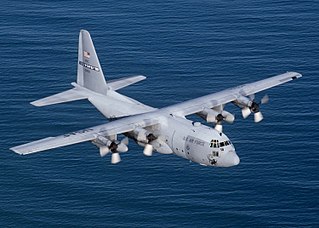
The Lockheed C-130 Hercules is an American four-engine turboprop military transport aircraft designed and built by Lockheed. Capable of using unprepared runways for takeoffs and landings, the C-130 was originally designed as a troop, medevac, and cargo transport aircraft. The versatile airframe has found uses in other roles, including as a gunship (AC-130), for airborne assault, search and rescue, scientific research support, weather reconnaissance, aerial refueling, maritime patrol, and aerial firefighting. It is now the main tactical airlifter for many military forces worldwide. More than 40 variants of the Hercules, including civilian versions marketed as the Lockheed L-100, operate in more than 60 nations.
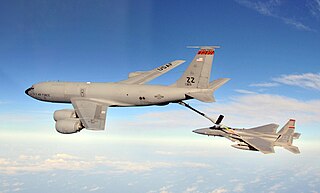
The Boeing KC-135 Stratotanker is an American military aerial refueling tanker aircraft that was developed from the Boeing 367-80 prototype, alongside the Boeing 707 airliner. It has a narrower fuselage and is shorter than the 707. Boeing gave the aircraft the internal designation of Model 717. The KC-135 was the United States Air Force (USAF)'s first jet-powered refueling tanker and replaced the KC-97 Stratofreighter. The KC-135 was initially tasked with refueling strategic bombers, but it was used extensively in the Vietnam War and later conflicts such as Operation Desert Storm to extend the range and endurance of US tactical fighters and bombers.

The Tenerife airport disaster occurred on 27 March 1977, when two Boeing 747 passenger jets collided on the runway at Los Rodeos Airport on the Spanish island of Tenerife. The collision occurred when KLM Flight 4805 initiated its takeoff run during dense fog while Pan Am Flight 1736 was still on the runway. The impact and resulting fire killed all on board KLM Flight 4805 and most of the occupants of Pan Am Flight 1736, with only 61 survivors in the front section of the aircraft. With a total of 583 fatalities, the disaster is the deadliest accident in aviation history.

The Ilyushin Il-76 is a multi-purpose, fixed-wing, four-engine turbofan strategic airlifter designed by the Soviet Union's Ilyushin design bureau as a commercial freighter in 1967, to replace the Antonov An-12. It was developed to deliver heavy machinery to remote, poorly served areas. Military versions of the Il-76 have been widely used in Europe, Asia and Africa, including use as an aerial refueling tanker or command center.

The Douglas C-124 Globemaster II, nicknamed "Old Shaky", is an American heavy-lift cargo aircraft built by the Douglas Aircraft Company in Long Beach, California.

The Boeing C-97 Stratofreighter was a long-range heavy military cargo aircraft developed from the B-29 and B-50 bombers. Design work began in 1942, the first of three prototype XC-97s flew on 9 November 1944 and the first of six service-test YC-97s flew on 11 March 1947. All nine were based on the 24ST alloy structure and Wright R-3350 engines of the B-29, but with a larger-diameter fuselage upper lobe and they had the B-29 vertical tail with the gunner's position blanked off. The first of three heavily revised YC-97A incorporating the re-engineered wing, taller vertical tail and larger Pratt & Whitney R-4360 engines of the B-50 bomber, flew on 28 January 1948 and was the basis of the subsequent sole YC-97B, all production C-97s, KC-97s and civilian Stratocruiser aircraft. Between 1944 and 1958, 888 C-97s in several versions were built, 811 being KC-97 tankers. C-97s served in the Berlin Airlift, the Korean War, and the Vietnam War. Some aircraft served as flying command posts for the Strategic Air Command, while others were modified for use in Aerospace Rescue and Recovery Squadrons (ARRS).

The Hump was the name given by Allied pilots in the Second World War to the eastern end of the Himalayan Mountains over which they flew military transport aircraft from India to China to resupply the Chinese war effort of Chiang Kai-shek and the units of the United States Army Air Forces (USAAF) based in China. Creating an airlift presented the USAAF a considerable challenge in 1942: it had no units trained or equipped for moving cargo, and there were no airfields in the China Burma India Theater (CBI) for basing the large number of transport aircraft that would be needed. Flying over the Himalayas was extremely dangerous and made more difficult by a lack of reliable charts, an absence of radio navigation aids, and a dearth of information about the weather.
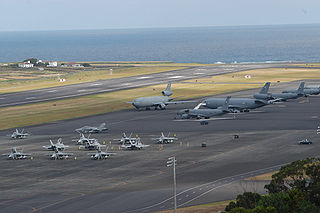
Lajes Field or Lajes Air Base, officially designated Air Base No. 4, is a multi-use airfield near Lajes and 15 km (9.3 mi) northeast of Angra do Heroísmo on Terceira Island in the Azores, Portugal. It is home to the Portuguese Air Force Base Aérea N º4 and Azores Air Zone Command, a United States Air Force detachment unit, and a regional air passenger terminal. Located about 3,680 km (2,290 mi) east of New York City and about 1,600 km (990 mi) west of Lisbon, Portugal; the base sits in a strategic location midway between North America and Europe in the north Atlantic Ocean.

The Fairchild C-119 Flying Boxcar was an American military transport aircraft developed from the World War II-era Fairchild C-82 Packet, designed to carry cargo, personnel, litter patients, and mechanized equipment, and to drop cargo and troops by parachute. The first C-119 made its initial flight in November 1947, and by the time production ceased in 1955, more than 1,100 had been built.
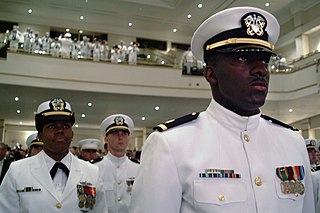
The Naval Reserve Officer Training Corps (NROTC) program is a college-based, commissioned officer training program of the United States Navy and the United States Marine Corps.
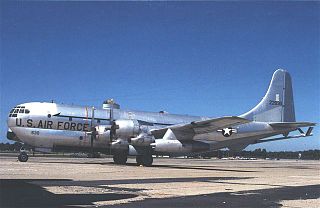
The Boeing KC-97 Stratofreighter is a four-engined, piston-powered United States strategic tanker aircraft based on the Boeing C-97 Stratofreighter. It replaced the KB-29 and was succeeded by the Boeing KC-135 Stratotanker.
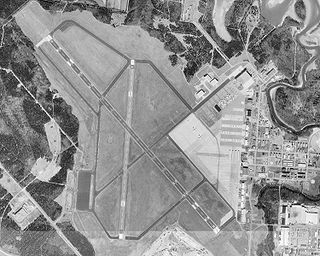
Smyrna Airport is a public general aviation and military use airport located two nautical miles (4 km) north of the central business district of Smyrna, a town in Rutherford County, Tennessee, United States. It is owned by the Smyrna / Rutherford County Airport Authority. Smyrna Airport is the third largest airport in Tennessee and is the state's busiest general aviation airport. Prior to March 1971, the facility was an active military installation known as Sewart Air Force Base.

The Tallmantz Phoenix P-1 was an FAA-certified one-off aircraft built for the 1965 film production The Flight of the Phoenix and used in the picture's final aerial sequences. Its pilot Paul Mantz was killed in an accident during a touch-and-go maneuver to simulate a takeoff, after which the plane was replaced by a crudely modified North American O-47A.
The US Navy had four programs for the training of naval aviators.

National Airlines Flight 102 (N8102/NCR102) was a cargo flight operated by National Airlines between Camp Shorabak in Afghanistan and Al Maktoum Airport in Dubai, with a refueling stop at Bagram Airfield, Afghanistan. On 29 April 2013, the Boeing 747-400 operating the flight crashed moments after taking off from Bagram, killing all seven people on board.

On 10 July 2017, a Lockheed KC-130T Hercules aircraft of the United States Marine Corps (USMC) crashed in Leflore County, Mississippi, killing all 16 people on board. The aircraft had the call sign "Yanky 72" and was from Marine Aerial Refueler Transport Squadron 452 (VMGR-452) based at Stewart Air National Guard Base, New York. Debris from the aircraft was found in Leflore County, Mississippi. The USMC released a statement calling the event a "mishap."















